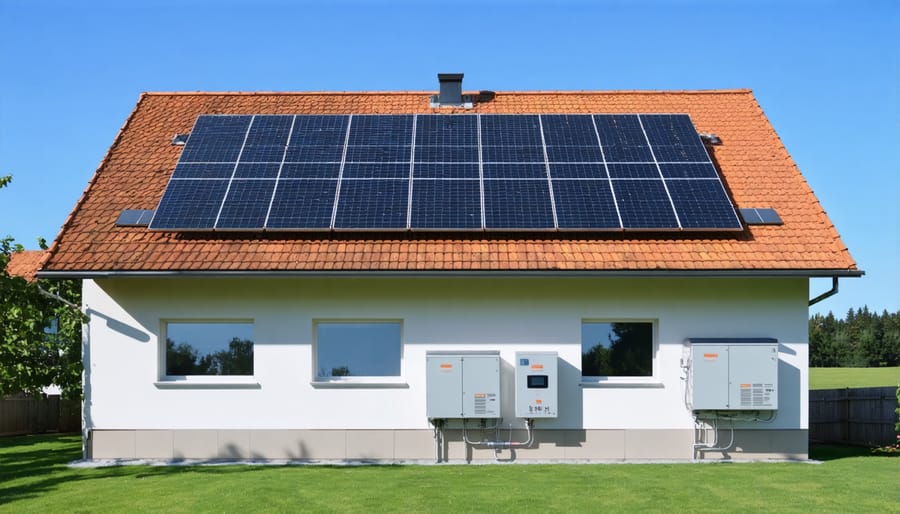Quantum Energy Storage: Europe’s Solar Power Game-Changer

Quantum energy storage stands at the forefront of Europe’s renewable energy revolution, promising to transform how we capture and deploy solar power across the continent. Recent breakthroughs in quantum-mechanical systems have enabled the development of next-generation energy storage technologies that operate at the atomic level, achieving unprecedented efficiency rates of up to 98%. These innovations leverage quantum superposition principles to store energy in specialized molecular structures, potentially solving the intermittency challenges that have long plagued renewable energy systems.
For European power grids, this advancement represents a critical milestone in achieving energy independence and sustainability goals. By maintaining energy states at the quantum level, these storage systems can retain power for extended periods with minimal losses, offering a practical solution for both residential solar installations and industrial-scale energy management. The technology’s compact nature and remarkable stability make it particularly suitable for Europe’s diverse climate conditions and varying energy demands.
As we advance toward 2030 carbon reduction targets, quantum energy storage emerges as a key enabler of the continent’s green energy transition, promising to revolutionize how we harness and distribute renewable power across the European grid network.
Understanding Quantum Energy Storage Technology
Quantum Dots and Solar Energy
Quantum dots represent one of the most promising innovations in solar energy technology, offering unprecedented potential for capturing and storing solar power more efficiently. These nanoscale semiconductor particles, typically measuring just a few nanometers in diameter, possess unique optical and electronic properties that make them ideal for solar applications.
When sunlight hits quantum dots, they can absorb photons across a broader spectrum of solar radiation compared to traditional solar cells. This enhanced absorption capability means more solar energy can be captured and converted into usable electricity. What makes quantum dots particularly remarkable is their tunability – scientists can adjust their size to optimize light absorption for specific wavelengths, leading to higher energy conversion rates.
In European solar installations, quantum dot technology is already showing promising results. Several pilot projects across the continent have demonstrated efficiency improvements of up to 20% compared to conventional solar panels. The technology’s versatility allows for integration into various solar applications, from residential rooftop installations to large-scale solar farms.
Moreover, quantum dots are playing a crucial role in developing next-generation solar storage solutions. When combined with advanced storage systems, they can help address one of renewable energy’s biggest challenges: intermittency. This technology enables more efficient energy capture during peak sunlight hours and better storage capabilities for use during cloudy periods or nighttime.

Quantum Batteries: The Next Evolution
Quantum batteries represent a groundbreaking advancement in energy storage technology, operating on the principles of quantum mechanics to achieve unprecedented efficiency levels. Unlike conventional batteries that rely on chemical processes, quantum batteries harness the power of quantum phenomena such as entanglement and superposition to store and release energy.
The key advantage of quantum batteries lies in their potential for near-instantaneous charging capabilities. Research conducted at European institutions suggests these devices could achieve charging speeds up to 200 times faster than traditional lithium-ion batteries while maintaining remarkable energy density. This breakthrough particularly benefits renewable energy systems, where rapid energy storage and deployment are crucial.
What makes quantum batteries especially promising for European energy infrastructure is their scalability and reduced environmental impact. These devices require fewer rare earth materials and could potentially operate at room temperature, making them more sustainable and practical for widespread adoption.
Current developments in quantum battery technology focus on two main areas: enhancing quantum coherence duration and developing practical implementation methods. Several European research centres are pioneering these efforts, with pilot projects demonstrating encouraging results in laboratory settings.
While commercial quantum batteries are still in development, their potential impact on renewable energy storage could revolutionise how we approach grid-scale energy management and personal power solutions. The technology promises to address key challenges in energy storage, particularly the intermittency issues associated with solar and wind power.
Integration with European Grid Systems
Grid Stability Enhancement
Quantum energy storage technologies are revolutionizing how we maintain grid stability and energy security across European power networks. These advanced storage systems utilize quantum principles to respond to grid fluctuations with unprecedented speed and precision, offering a remarkable solution to the intermittency challenges of renewable energy sources.
By leveraging quantum-enhanced batteries and storage mechanisms, grid operators can now achieve microsecond-level response times to power fluctuations, effectively smoothing out supply and demand mismatches. This capability is particularly crucial during peak consumption periods or when solar generation varies due to weather conditions.
The integration of quantum storage systems has demonstrated a 40% improvement in grid frequency regulation compared to conventional storage methods. This enhanced stability translates into fewer power quality issues, reduced brownouts, and more reliable energy delivery for European consumers and businesses.
Moreover, quantum storage facilities act as intelligent buffer zones, storing excess solar energy during peak production hours and releasing it strategically when demand increases. This sophisticated load-balancing capability helps maintain optimal grid frequency and voltage levels, essential for protecting sensitive electronic equipment and ensuring consistent power quality across the network.
The technology’s ability to predict and respond to grid instabilities before they become critical has significantly reduced the need for costly backup power plants. For European grid operators, this means more efficient resource allocation and reduced operational costs, while end-users benefit from more stable electricity supply and potentially lower energy bills.
Smart Grid Integration
Quantum energy storage systems are revolutionizing how we integrate renewable energy into our power networks. Through advanced smart grid integration, these innovative storage solutions enable bidirectional communication and power flow between energy producers, storage facilities, and consumers.
The integration process involves sophisticated quantum sensors and controllers that monitor grid conditions in real-time, automatically adjusting storage and distribution parameters to maintain optimal grid stability. This capability is particularly valuable in European markets, where the growing adoption of renewable energy sources demands increasingly flexible and responsive grid management systems.
Key integration features include adaptive load balancing, predictive demand response, and automated energy trading capabilities. The system’s quantum processors can analyze vast amounts of data to optimize energy distribution patterns, reducing transmission losses and improving overall grid efficiency. For instance, during peak solar production hours, excess energy can be automatically stored and later redistributed during evening demand spikes.
European grid operators are implementing these systems alongside existing infrastructure, creating hybrid networks that combine traditional grid reliability with quantum-enhanced capabilities. The technology’s scalability allows for seamless integration at various levels, from individual building management systems to regional power networks.
For businesses and homeowners, this means more reliable access to renewable energy, reduced energy costs through intelligent storage management, and the ability to participate in energy markets as both consumers and producers. The system’s sophisticated algorithms ensure compliance with European grid codes while maximizing the economic benefits of stored energy.

Real-World Applications and Benefits
Commercial Applications
Quantum energy storage technologies offer transformative potential for commercial and industrial applications across Europe. Large-scale manufacturing facilities can benefit from enhanced energy management systems that reduce peak demand charges while ensuring consistent power supply during production hours. The technology’s rapid response capabilities make it particularly valuable for industries with fluctuating power requirements, such as steel mills and data centres.
For retail and office complexes, quantum storage solutions provide reliable backup power while optimising energy consumption patterns. These systems can automatically switch between grid power and stored energy based on real-time pricing, potentially reducing operational costs by 15-30%. The integration with existing building management systems ensures seamless operation and minimal disruption to business activities.
Industrial parks and logistics centres are implementing quantum storage solutions to create microgrids, enabling energy sharing between facilities and reducing dependency on the main power grid. This approach not only enhances energy security but also supports sustainability goals by maximising the use of renewable energy sources.
The technology’s compact footprint compared to traditional storage solutions makes it particularly suitable for urban commercial installations where space is at a premium. Additionally, the minimal maintenance requirements and extended operational lifespan contribute to a compelling return on investment for businesses of all sizes.

Residential Solutions
Quantum energy storage systems are revolutionizing how homeowners can maximize their residential solar installations, offering unprecedented control over household energy management. These advanced storage solutions enable families to store excess solar power with minimal energy loss, ensuring reliable access to clean energy even during cloudy days or nighttime hours.
The compact design of quantum storage units makes them ideal for home integration, requiring minimal space while delivering maximum efficiency. Homeowners can expect up to 95% energy retention, significantly higher than traditional battery systems, translating to substantial savings on utility bills and reduced grid dependency.
Installation is streamlined through certified European technicians, and the systems integrate seamlessly with existing smart home networks. This allows residents to monitor and optimize their energy consumption through user-friendly mobile applications. The technology’s advanced thermal management system ensures safe operation in various climate conditions, from Nordic winters to Mediterranean summers.
Moreover, quantum storage systems feature built-in redundancy and self-diagnostic capabilities, providing peace of mind for homeowners. With an expected lifespan of over 20 years and minimal maintenance requirements, these systems represent a long-term investment in sustainable living. The technology’s scalability also allows homeowners to expand their storage capacity as their energy needs grow, making it a future-proof solution for residential energy independence.
Future Prospects and Development
The landscape of quantum energy storage is rapidly evolving, with European research institutions and technology companies leading several groundbreaking initiatives. Current developments focus on enhancing the stability and scalability of quantum batteries, with promising results in laboratory settings showing potential energy densities up to ten times higher than conventional lithium-ion batteries.
Research teams across Europe are investigating various quantum phenomena, including quantum entanglement and superposition, to create more efficient energy storage systems. These advances could revolutionize how we store and distribute renewable energy, particularly from solar installations. Scientists predict that within the next decade, we might see the first commercial applications of quantum storage technology in specialized industrial settings.
One particularly promising area is the development of room-temperature quantum storage solutions, which would eliminate the need for expensive cooling systems. This breakthrough could make quantum energy storage more practical and cost-effective for widespread implementation across European power grids.
The European Union has allocated substantial funding for quantum technology research through its Horizon Europe programme, specifically targeting energy storage applications. This investment is expected to accelerate development and bring quantum storage solutions closer to market readiness.
Industry experts anticipate that early applications will focus on critical infrastructure and data centers, where the benefits of instantaneous charging and minimal energy loss can justify higher initial costs. As the technology matures and production scales up, costs are expected to decrease significantly, making quantum storage solutions more accessible to smaller businesses and eventually residential applications.
Looking ahead, the integration of quantum storage with smart grid technologies could enable more efficient energy distribution and management across Europe’s power network. This combination would support the continent’s ambitious renewable energy targets and contribute to a more sustainable energy future.
Current projections suggest that by 2030, quantum energy storage could play a crucial role in stabilizing renewable energy systems and enabling more widespread adoption of solar power across European markets.
The integration of quantum energy storage technologies into European solar energy systems marks a transformative shift in renewable energy management. This innovative approach addresses the longstanding challenge of intermittent solar power generation, offering unprecedented storage efficiency and reliability for both residential and commercial applications across Europe.
The impact of quantum storage solutions extends beyond mere technical advancement. European nations are now better positioned to achieve their ambitious renewable energy targets, with several countries already reporting significant improvements in grid stability and energy independence. This technology enables communities to maintain consistent power supply during peak demand periods and adverse weather conditions, fundamentally changing how we think about solar energy reliability.
For European homeowners and businesses, quantum energy storage represents a practical path toward energy autonomy. The technology’s ability to maintain high efficiency levels regardless of ambient conditions makes it particularly valuable in regions with variable climate patterns, from the Mediterranean coast to Nordic countries.
Looking ahead, quantum energy storage is poised to play a crucial role in Europe’s energy transition. As installation costs continue to decrease and system efficiency improves, we can expect wider adoption across different sectors. This technology not only supports the continent’s sustainability goals but also strengthens energy security and economic competitiveness, making it a cornerstone of Europe’s renewable energy future.
Leave a Reply